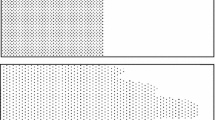Abstract
Typicality has always been in the minds of the founding fathers of probability theory when probabilistic reasoning is applied to the real world. However, the role of typicality is not always appreciated. An example is the article “Foundations of statistical mechanics and the status of Born’s rule in de Broglie-Bohm pilot-wave theory” by Antony Valentini (Valentini in Statistical Mechanics and Scientific Explanation. World Scientific, [1]), where he presents typicality and relaxation to equilibrium as distinct approaches to the proof of Born’s rule, while typicality is in fact an overriding necessity. Moreover the “typicality approach” to Born’s rule of “the Bohmian mechanics school” is claimed to be inherently circular. We wish to explain once more in very simple terms why the accusation is off target and why “relaxation to equilibrium” is neither necessary nor sufficient to justify Born’s rule.
Access this chapter
Tax calculation will be finalised at checkout
Purchases are for personal use only
Similar content being viewed by others
Notes
- 1.
Luckily, for what we have to say here, we can ignore the issues related to the question what the notion of “probability 1/2” really means. It does not matter.
- 2.
“Most” should be understood as “overwhelmingly many”.
- 3.
For more on this, see the chapter “Chance in Physics” in [4].
- 4.
Dimension of the size of Avogadro’s number perhaps.
- 5.
In classical mechanics, there are many more measures which share this property, but that does not matter for our concerns here.
- 6.
A technical remark on the side: To model the coin tossing experiment in which the coin is thrown a great number of times in a physically realistic way is not so easy and to prove the LLN may turn out hard: The stochastic independence of the different tosses of the coin is easily said, but to prove that in a physically realistic model is far from being easy (see [4], chapter “Chance in Physics” for an elaboration on that).
- 7.
The empirical density is in this case given by \(\rho ^N_\mathrm{emp} (q,\mathbf{x}) = \frac{1}{N} \sum ^N_{k = 1} \delta (\mathbf{x} - \mathbf{x}_i)\), where \(\mathbf{x}_i\) is the position of the ith particle. Note the analogy with the definition in the case of the coin tossing.
- 8.
Think of this wave function as the usual wave function of a system as it is used in physics courses.
- 9.
As an aside, note that the typicality measure which is used in the LLN is really a member of an equivalence set of measures. That is, all measures which are absolutely continuous with respect to \(\mathbb {P}^{\Psi }\) yield a LLN for Born’s law.
- 10.
It has been proven under very reasonable conditions in [7] that this measure is unique.
- 11.
This involves in some way or another an analysis of measurement situations, which in Bohmian mechanics is straightforward, and which in let’s say orthodox quantum theory needs the problematical collapse of the wave function.
References
Valentini, A., Foundations of statistical mechanics and the status of the Born rule in de Broglie-Bohm pilot-wave theory. in: Statistical Mechanics and Scientific Explanation, Editor: Allori, V. Publisher: World Scientific (2020) (arXiv:1906.10761).
Shafer, G. & Vovk, V., The Sources of Kolmogorov’s Grundbegriffe. Statistical Science 21, 70–98, https://doi.org/10.1214/088342305000000467 (2006).
Dürr, D., Goldstein, S. & Zanghì, N. Quantum equilibrium and the origin of absolute uncertainty. J. Stat. Phys. 67, 843–907, https://doi.org/10.1007/BF01049004 (1992).
Dürr, D. & Teufel, S. Bohmian Mechanics, The Physics and Mathematics of Quantum Theory. Springer (2009).
Kac, M., Probability and Related Topics in Physical Sciences. Interscience Publishers Inc. (1959).
Dürr, D., Goldstein, S. & Zanghì, N. Quantum equilibrium and the role of operators as observables in quantum theory. J. Stat. Phys. 116, 959–1055, https://doi.org/10.1023/B:JOSS.0000 (2004).
Goldstein, S. & Struyve, W. On the Uniqueness of Quantum Equilibrium in Bohmian Mechanics J. Stat. Phys. 128, https://doi.org/10.1007/s10955-007-9354-5 (2007).
Acknowledgments
W.S. is supported by the Research Foundation Flanders (Fonds Wetenschappelijk Onderzoek, FWO), Grant No. G066918N.
Author information
Authors and Affiliations
Corresponding author
Editor information
Editors and Affiliations
Rights and permissions
Copyright information
© 2021 Springer Nature Switzerland AG
About this chapter
Cite this chapter
Dürr, D., Struyve, W. (2021). Typicality in the Foundations of Statistical Physics and Born’s Rule. In: Allori, V., Bassi, A., Dürr, D., Zanghi, N. (eds) Do Wave Functions Jump? . Fundamental Theories of Physics, vol 198. Springer, Cham. https://doi.org/10.1007/978-3-030-46777-7_3
Download citation
DOI: https://doi.org/10.1007/978-3-030-46777-7_3
Published:
Publisher Name: Springer, Cham
Print ISBN: 978-3-030-46776-0
Online ISBN: 978-3-030-46777-7
eBook Packages: Physics and AstronomyPhysics and Astronomy (R0)




